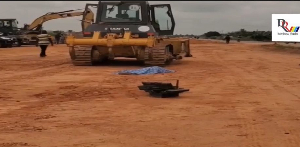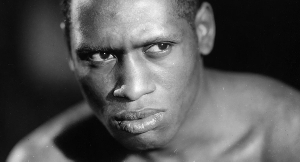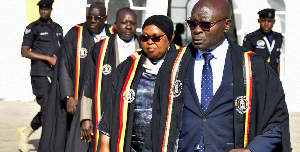For it is often said,one person does not observe the flickering lights
of a witch. I would like to thank one lady who wants to be known and
called ''Odopa''. She tries setting up an NGO called Odopa Social
services and is not easy for her now. It shall be well Insha Allah. As
we shop around the streets of Accra and other parts of the regional
capitals whether as housewives, government officials or tourists, it
ought to dawn on us that on a daily basis and hour by hour and minute by
minute we are glossing over a serious criminality. The kayaye who are
mainly young girls under the age of eighteen (18) and who do head
porterage can be seen clearly carrying various food and hardware items
on their heads. If they were merely engaging in external household
chores as part of their domestic training and upbringing, it shouldn’t
raise any eyebrows. The kayaye of Accra however are really child
labourers who have travelled mainly from various Northern parts to Accra
in search of work.
As a young man,the history of Kayaye labour
emerging from the north to Accra and other southern parts is as old as
the Gold Coast itself and the modern times will be the 1994 konkomba war
in the Northern Region. Labour was recruited from the north to the
south in the Gold Coast period to work on cocoa farms, in the mining
areas and even for enlistment into the Ghana Police Service and the Army
with the latter being as a result of the proverbial height of northern
people which was seen as an advantage for policing in particular. But
these movements were about able bodied men freely recruited to work for a
living. Naturally, a certain aspect of migration would have evolved out
of this because some people decided to retire and live in the south and
perhaps give their children an advantage of a better education in
southern schools.
The concept of child labour has been defined as
the using of legal perspectives of who a child is. According to the 1992
Constitution of Ghana a child is anyone under the age of eighteen (18)
years. Go to Mallam Atta Market around eight in the night,children from 7
are sleeping in varandars because of the tiredness of the working day.
Given the definition of a child, the ILO convention 138 defines child
labour as “labour that is performed by a child who is under the minimum
age for the kind of work (as defined by national legislation, in
accordance with accepted international standards) and that is those
likely to impede the child’s education and full development”. Child
labour therefore depends on the child’s age, types of work performed,
conditions or environment under which the work is performed, tools used
and the number of hours worked. Working children are frequently exposed
to jobs that are morally or psychologically damaging, hours that are
excessive, conditions that are unsafe, employment contracts that equate
with slavery or, at least economic exploitation. Such types of child
labour also represented a violation of the rights of children.
The
worst forms of child labour as the engagement of children under eighteen
(18) years in all forms of slavery and similar practices, prostitution
and pornography, illicit activities and hazardous work; and work which
by its nature or the circumstances in which it is carried out, is likely
to harm the health, safety or morals of children.
Various
factors have been associated with the phenomenon of child labour in
Ghana. Some of these include poverty, lack of parental care and peer
influence and other things. All forms of child labour are offensive and
unacceptable. The majority of these appear to be on the blind side of
Ghanaians but even then, we have all been witnesses to the harm that
child labour cause this country,especially in the Cocoa sector.
Kayaye however, is visible, its about children spanning ages 8 – 15
years. They do not attend school, they face severe health hazards, they
live in squalor and some drift toward night work which has serious
connotations on sex work. Whatever the kayaye are involved in have also
implications on breaches on the 1992 Constitution with respect to the
right to life (Article 13), personal liberty (Article 14), right to
human dignity (Article 15) and equality and freedom from discrimination
(Article 17). The Children’s Act has several references to the
protection of the child particularly Section 87 which states that: 1) No
person shall engage a child in exploitative labour
2) Labour is exploitative of a child if it deprives the child of his/her health,
education and development
There are therefore serious concerns that infringe on the laws of Ghana
as well as International Law and yet we look on as if we cannot solve
the problem associated thereof.
We cannot solve these problems
without reference to regulatory authorities generally in Ghana. Most
things work in Ghana except those that require regulation. People park
under no parking signs, people sell on pavements, people throw garbage
around and the level of misconduct could be endless yet city authorities
who should enforce regulations say they have no funds to operate with.
Meanwhile, all these offenses attract fines that could create liquidity
for the assemblies. The Children’s Act empowers District Assemblies, the
Police and the Department of Social Welfare to act as appropriate when
children are being abused by being rushed into dehumanizing work and yet
the kayaye are strewn across the streets of Accra and other urban areas
carrying overloaded merchandise and impugning upon the integrity of
womanhood. I'm worry for Ghana in this particular area because as I
travel around, I do no see the practice of this phenomenon; female head
porterage on a massive scale as I see in this country. I know there are
a lot of men/women who want to help but this is a particular area we
want leadership to emerge to support people like Odopa of Odopa social
services. I know jobs are difficult to come by but if we improve upon
agriculture and have the forward and backward linkages that will
re-establish the rice mills as well as the oil mills, tomato and meat
factories, I believe a step would have been taken in the right direction
and the people would have the chance of working in their regions to
survive.
I dedicate this piece to a lady ''ODOPA'' who travels
hours to help this poor people and to seek support to enable her
establish a center for them. May Almighty brings true people who would
help this lady achieve her dreams of reducing this Kayaye situation.
Ibrahim Hardi 0208235615
Email;bigkolaaya@yahoo.com
Opinions of Monday, 21 October 2013
Columnist: Hardi, Ibrahim














